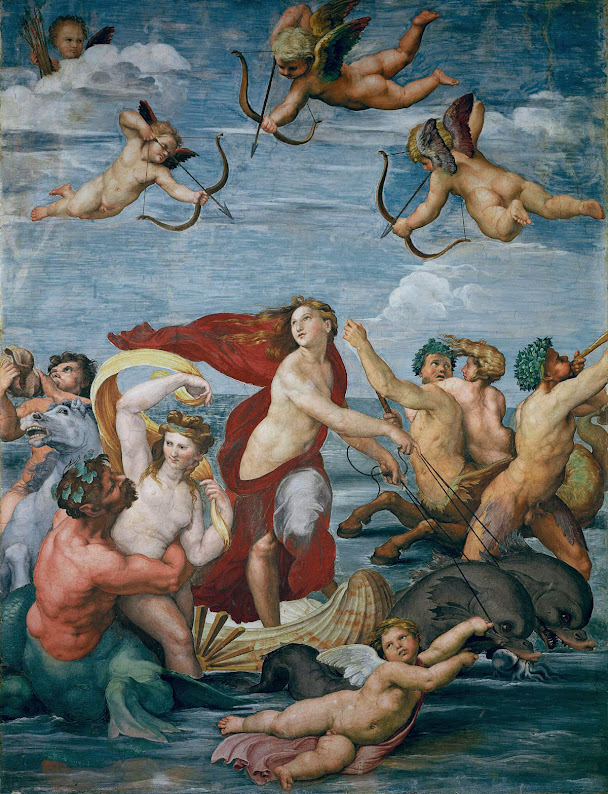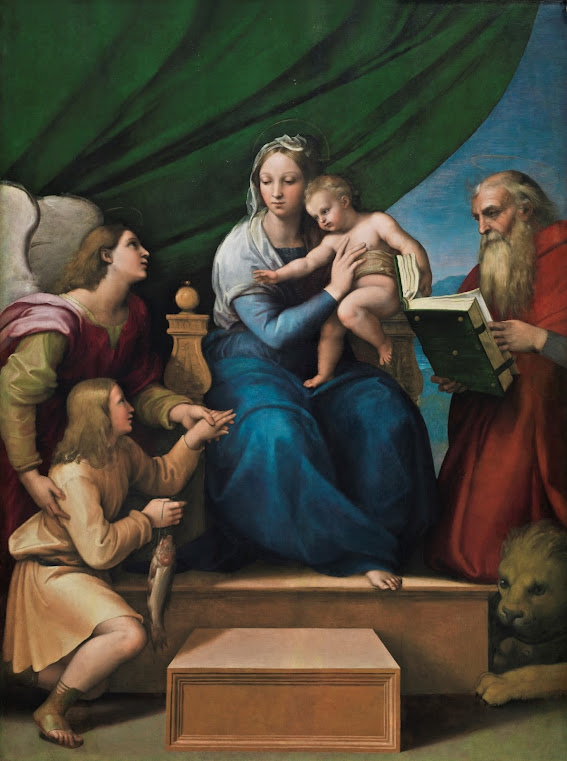For centuries Raphael has been recognised as the supreme High Renaissance painter, more versatile than Michaelangelo and more prolific than their older contemporary Leonardo. Though he died at 37, Raphael's example as a paragon of classicism dominated the academic tradition of European painting until the mid-19th century.
Raphael (Raffaello Santi) was born in Urbino where his father, Giovanni Santi, was court painter. He almost certainly began his training there and must have known works by Mantegna, Uccello, and Piero della Francesca from an early age. His earliest paintings were also greatly influenced by Purgino. From 1500 - when he became an independent master - to 1508 he worked throughout central Italy, particularly Florence, where he became a noted portraitist and painter of Madonnas.
In 1508, at the age of 25, he was called to the court of Pope Julius II to help with the redecoration of the papal apartments. In Rome he evolved as a portraitist, and became one of the greatest of all history painters.
He remained in Rome for the rest of his life and in 1514, on the death of Bramante, he was appointed architect in charge of St Peter’s.
For earlier works see parts 1 - 4 also.
This is part 5 of 5 parts on the works of Raphael:
(Apologies for continued font glitches on the blogspot template)
 |
| c1513 A Marble Horse on the Quirinal Hill red chalk and pen and brown ink, with stylus underdrawing and traces of lead-point on laid paper 21.9 x 27.4 cm National Gallery of Art, Washington, DC |
 |
| c1513 Madonna of the Candelabra ( Workshop of Raphael ) 65.7 x 64 cm The Walters Art Museum, Baltimore |
 |
| 1514 Sybils receiving instruction from Angels fresco, 615 cm across the base Santa Maria della Pace, Rome |
 |
| 1514-1515 Two apostles' heads black stone, watercolour ( for the figures ), pen and brown ink, white highlights and gouache 38.5 x 50.2 cm © RMN-Grand Palais Domaine de Chantilly |
c1514-1515 Portrait of Baldassare Castiglione
The portrait was produced as a result of Raphael's friendship with Castiglione, whose ascent in courtly circles paralleled that of the artist. They were close friends by 1504, when Castiglione made his second visit to Urbino, as Raphael was gaining recognition as an artist in the humanist circle of the city's ducal court. Raphael was commissioned by Guidobaldo da Montefeltro in 1505 to paint a picture for Henry VII; Castiglione traveled to England to present the finished painting to the king. It is possible that Castiglione later served as a "scholarly advisor" for Raphael’s The School of Athens, and that the depiction of Zoroaster in that fresco may be a portrait of the courtier.
 |
| c1514-1515 Portrait of Baldassare Castiglione ( attributed to ) oil on canvas 82 x 67 cm Louvre, Paris |
 |
| c1514-1516 Christ Carrying the Cross oil on panel transferred to canvas 318 x 229 cm Museo del Prado, Madrid |
 |
| 1514-1517 Man half draped, three-quarters to the right, carrying a burden sanguine on paper 32.1 x 16.1 cm © RMN-Grand Palais Domaine de Chantilly |
 |
| c1514-1517 The Ecstasy of St. Cecilia oil transferred from panel to canvas 220 x 136 cm Pinacoteca Nazionale, Bologna |
 |
| c1514 Eight Apostles red chalk over stylus underdrawing and traces of lead-point on laid paper 8.1 x 23.2 cm National Gallery of Art, Washington, DC |
 |
| c1514 Young man carrying an old man on his back red chalk Albertina, Vienna, Austria |
 |
| 1515 Nude Studies red chalk and metal-point Albertina, Vienna |
1515-1516 The Raphael Cartoons
The Raphael Cartoons are seven large cartoons for tapestries, belonging to the British Royal Collection, but since 1865 on loan to the Victoria & Albert Museum in London Designed by Raphael in 1515–16 and showing scenes from the Gospels and Acts of the Apostles. They are the only surviving members of a set of ten cartoons commissioned by Pope Leo X for the Sistine Chapel tapestries for the Sistine Chapel in the Vatican Palace, which are still (on special occasions) hung below Michaelangelo’s famous ceiling.
 |
| Christ's Charge to Peter tempera on paper mounted on canvas 345 x 535 cm Royal Collection, Victoria & Albert Museum, London |
 |
| St Paul Preaching in Athens tempera on paper mounted on canvas 390 x 440 cm Royal Collection, Victoria & Albert Museum, London |
 |
| The Conversion of the Proconsul tempera on paper mounted on canvas 385 x 445 cm Royal Collection, Victoria & Albert Museum, London |
 |
| The Death of Ananias tempera on paper mounted on canvas Royal Collection, Victoria & Albert Museum, London |
 |
| The Healing of the Lame Man tempera on paper mounted on canvas 340 x 540 cm Royal Collection, Victoria & Albert Museum, London |
 |
| The Miraculous Draught of Fishes tempera over charcoal on paper, mounted on canvas 360 x 400 cm Royal Collection, Victoria & Albert Museum, London |
 |
| The Sacrifice at Lystra tempera on paper mounted on canvas 350 x 540 cm Royal Collection, Victoria & Albert Museum, London |
 |
| c1515-1516 Study for a figure of the Almighty red chalk over blind stylus 21.4 x 20.9 cm Ashmolean Museum, University of Oxford |
 |
| 1515-1520 The Transfiguration tempera on wood panel 410 x 279 cm Pinacoteca Vaticana, Vatican City |
1516 Creation of the World mosaic
Creation of the World is a mosaic composition in the dome of the Chogo Chapel in Santa Maria del Popolo, Rome, designed by Raphael. The chapel itself was designed by Raphael for his friend and patron, banker Agostino Chigi as a private chapel and family burial place. The dome was decorated with mosaics, a somewhat unusual and old-fashioned technique in the 16th century. Raphael's cartoons were executed by a Venetian craftsman, Luigi da Pace in 1516. The original cartoons were lost but some preparatory drawings, that confirm the originality of the work, survived in the Ashmolean Museum, Oxford.
 |
| 1516 Creation of the World mosaic Chigi Chapel, Rome |
 |
| 1516 Eight Seated Bishops red chalk 26.1 x 31.8 cm Museum Kunstpalast, Düsseldorf, Sammlung der Kunstakademie |
 |
| 1516 Portrait of Andrea Navagero and Agostino Beazzano oil on canvas 76 x 107 cm Galleria Doria Pamphilj, Rome |
 |
| 1516 The Elephant Hanno pen and brownish black ink over traces of black chalk, with white highlights; on greyish brown paper 27.9 x 28.5 cm Kupferstichkabinett, Staatliche Museen zu Berlin |
 |
| c1516-1518 Madonna of Divine Love oil on wood panel 140 x 109 cm National Museum of Capodimonte, Naples, Italy |
 |
| c1516-1520 Portrait of a Young Woman ( by Raphael and Giulio Romano ) oil on poplar wood panel 60 x 44 cm Musée des Beaux-Arts, Strasbourg |
 |
c1516 La Velata oil on canvas 82 x 60.5 cm Palantine Gallery, Pitti Palace, Florence |
 |
| c1516 Portrait of Cardinal Bibbiena oil on canvas 85 x 66.3 cm Palantine Gallery, Pitti Palace, Florence |
 |
| c1517 The Visitation oil on panel transferred to canvas 200 x 145 cm Museo del Prado, Madrid |
 |
| 1518 St. Michael Vanquishing Satan oil on panel transferred to canvas 268 x 160 cm Louvre Paris |
 |
| 1518 The Holy Family of Francis I oil on canvas transferred from wood 207 x 140 cm Louvre, Paris |
 |
| 1518-1519 Portrait of a Young Woman ( La Fornari ) oil on wood panel 85 x 60 cm Galleria Nazionale d'Arte Antica, Rome |
1518-1519 Self-Portrait with a Friend
The identity of the man portrayed before Raphael is unknown. Traditionally he was identified as his fencing master, since he holds the hilt of a sword. Modern art historians consider him as a close friend, or possibly one of the painter's pupils, perhaps Polidoro da Caravaggio or Giulio Romano. One possibility is Giovanni Battista Branconio, for whom Raphael had designed, in the Borgo quarter of Rome, the now destroyed Palazzo Branconio. Other people associated with the character include Pietro Aretino, Balsassarre Peruzzi and Antonio da Sangallo the Younger, as well as other painters such as Il Pordenone or Pontormo, but these hypotheses have been refuted by other portraits. A significant portion of the painting seems to have been executed by one of Raphael's pupils. The painting was owned by Francis I of France and, in the past, was assigned to other artists, including Sebastiano del Piombo.
 |
| 1518-1519 Self-Portrait with a Friend oil on canvas 99 x 83 cm Louvre, Paris |
 |
| c1518-1519 Small Holy Family ( Raphael and workshop ) oil on wood panel 38 x 32 cm Louvre, Paris |
 |
| 1518-1520 Madonna of the Rose ( possibly assisted by Giulio Romano ) 103 x 84 cm Museo del Prado, Madrid |
1518-1520c Portrait of Pope Leo X with two Cardinals
The painting depicts Pope Leo X (Giovanni de' Medici, 1475-1521), son of Lorenzo il Magnifico, with Giulio de' Medici (1478-1534), future Pope Clement VII to the left and Luigi de Rossi (1474-1519), his cousin, to the right. The painting was sent to Florence in 1518 for the wedding of Lorenzo de’ Medici, Duke of Urbino, and Maddalena de la Tour d'Auvergne. It was exhibited in the tribune from 1589.
 |
| c1518-1520 Portrait of Pope Leo X with two Cardinals oil on wood 154 x 119 cm Uffizi Gallery, Florence, Italy |
 |
| c1518 A Kneeling nude woman with her left arm raised red chalk, with touches of black chalk, over stylus underdrawing on off-white paper 27.9 x 18.7 cm National Galleries Scotland, UK |
 |
| c1518 Ezekiel's Vision oil on panel 40 x 30 cm Palantine Gallery, Pitti Palace, Florence |
 |
| c1518 Portrait of Doña Isabel de Requesens, Vice-Reine of Naples oil on canvas ( transferred from wood ) 120 x 95 cm Louvre, Paris |
 |
| c1518 St. Margaret oil on poplar wood panel 191.3 x 123 cm Kunsthistorisches Museum Vienna ©KHM-Museumsverband |
 |
| 1519-1520 Head of an Apostle in the Transfiguration black chalk over traces of a metal-stylus preliminary drawing Albertina, Vienna, Austria |
1519-1520c Head of a Young Apostle
The drawing nearly tripled its pre-sale estimate of £10-15 million ($16-24 million), as four bidders battled over the work on paper for 17 minutes. (It sold for £29.7 million). The black chalk rendering shows one of the primary figures from Raphael's "The Transfiguration," which is considered to be one of the greatest Renaissance-era paintings and now hangs in the halls of the Vatican Museum in Rome. "Head of a Young Apostle" is one of only three Raphael drawings of this significance. Over the last 50 years at auction, all three of the drawings have set records for Old Master works at sale.
 |
| c1519-1520 Head of a Young Apostle black chalk over pounced, dotted outlines on paper 37.5 x 27.8 cm |




































